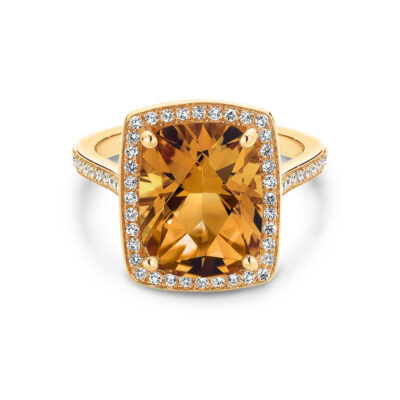Citrine
The name comes from the French word “citron” meaning yellow, this glowing gem comes in transparent shades of yellows. However today much of the citrine is heat treated to enhance its colour and to bring out the intense colours of dark orange-brown and reddish-brown. It belongs to the quartz family and the presence of iron gives it the vibrant colour. Darker colours are said to be more valuable. Citrine has a glassy looking shine when cut and polished. The most common cut is brilliant round and ovals as it tends to maximise the colour. Citrine’s attractive colour, durability, affordability and it being available in any shape is the reason that it has become the top-selling yellow to orange gem.
Citrine is mainly found in Brazil however most of these are heat treated, more of the natural gem can also be found in Spain, Madagascar and France the crystals can form together with amethyst or smoke quartz to for a bi-coloured gem called Ametrine. Citrine is a hard wearing gem and suitable for everyday wear and tear.
Its vibrant colour is said to bring vibrant energy and believed to bring fortune and good luck. It is the gemstone that represents birth month of November and accepted for 13th wedding anniversary.

Citrine Care
Citrine is a strong gemstone however it will need special care to keep it looking as good as the day it was bought. Citrine should be stored in a soft pouch or jewellery box to prevent scratching. Soap and liquid cleaners should be avoided as these may cause the stone to become dull. Harsh detergents or chemicals such as bleach or chlorine could cause erosion of the stone. To clean citrine rinse thoroughly with water and dry with a soft jewellery cloth. Citrine is sensitive to light and heat so should not be worn in situations such as sunbathing. Citrine should be stored out of direct sunlight as colour can fade with prolonged exposure to sunlight.
